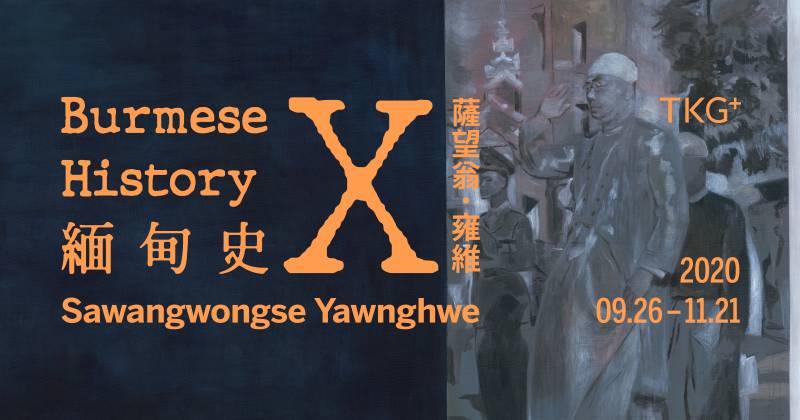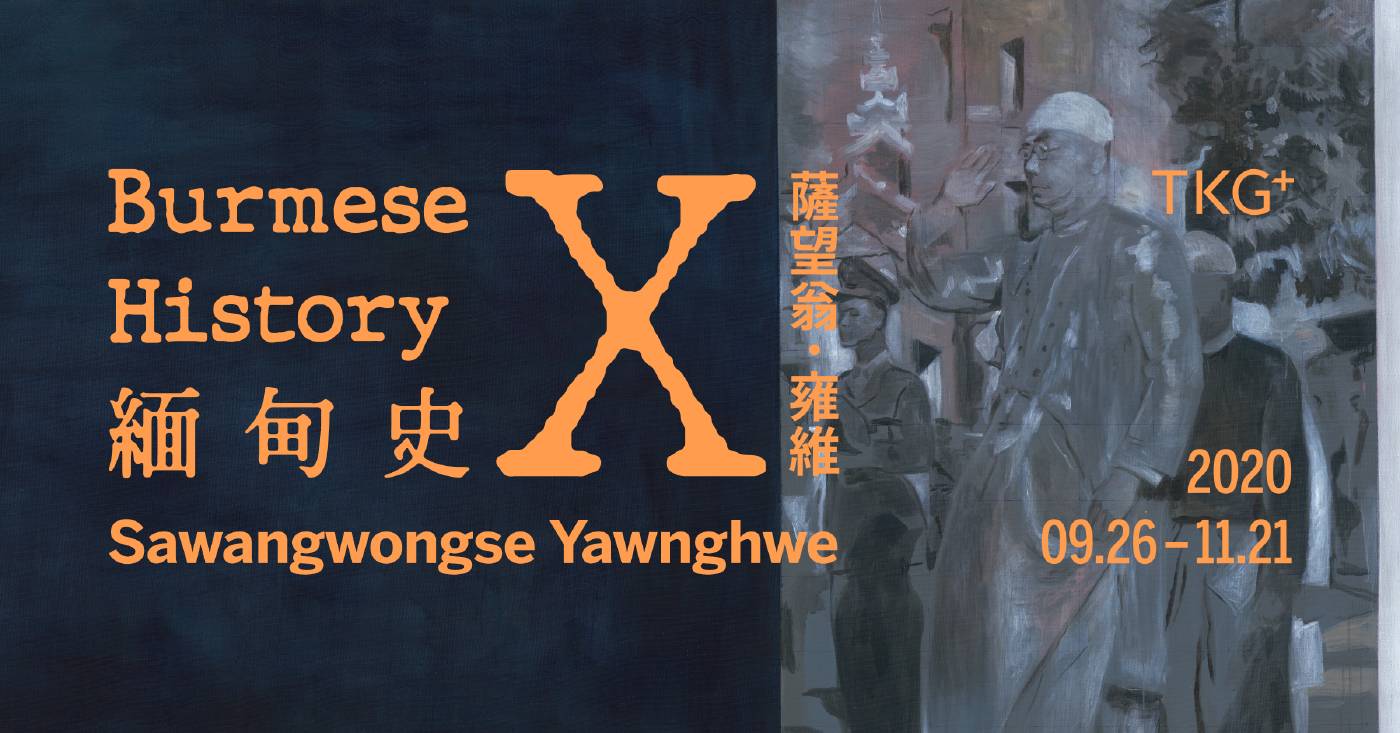TKG+
【緬甸史.X】薩望翁.雍維個展

-
展期
日期:2020-09-26 ~ 2020-11-21
-
地點
台北市內湖區瑞光路548巷15號B1
-
參展藝術家
薩望翁.雍維
-
展期|09.26.2020 – 11.21.2020
開幕|09.26.2020(六)4:30 p.m.
地點|TKG+(台北市內湖區瑞光路548巷15號B1)
反史學、批判以緬族為中心的主流歷史述事,一直是薩望翁.雍維(Sawangwongse Yawnghwe)的創作核心。雍維的作品虛構與現實交錯,源自歷史場景與家族照片,以及父親去世後留給他的隨身筆記,並透過縝密的研究,與緬甸學者、人權份子、記者及作家互動。他運用研究調查方法切入哲學問題,思考當少數族裔敘事遭到瓦解和抹滅時,歷史是否還具有意義;同時批判現代主義與資本主義的結合,成為了民族壓迫的超級源頭,試圖描繪其中的矛盾、政治流動與後續影響。
許多撣族(Shan)及緬甸其他少數族裔數十年來的流亡,相較於一般認知的法律定義,多了一層離散(diaspora)的心理狀態,不只是因軍政府迫害而離開自己的土地,更多的是家鄉已不復在、無從返鄉的愁緒,雍維始終沈浸在一種從未擁有的失去之中。而家國意識的匱乏,使其靈魂無法完整。如同紀傑克(Slavoj Žižek)在其著作《Absolute Recoil: Towards A New Foundation of Dialectical Materialism》(2014)所提及,麥爾坎.X(Malcolm X)將X作為自己的姓氏,旨在表明當奴隸販將其祖先帶離故土時,剝奪了他們的家庭、種族根源和文化世界,而其關鍵並非動員非裔族群為回到非洲而鬥爭,而在於抓住X所提供的機會 —— 一種未知的新(匱乏)身份,這種身份便是從永遠失去根源的奴役過程中所產生的。
靈魂的傷口無法癒合,亦無法再次完整,以X作為拆解X本身的對象,在這次TKG+的個展「緬甸史.X」,雍維回到家族被流放的災難起始點,從零開始,這是相對於「良瑞流亡辦公室」在本體論上的另一個新起點,也將在未來持續的發展。雍維的繪畫作為一種後結構主義式的歷史文本,認為在一個文本之外,中立、全知的觀點是不可能存在的。他以家族收藏的照片和他所搜集的檔案資料為基礎,融合了緬甸歷史與現代藝術的圖象學。雍維將照片與各種平面單色塊併置,使具象和抽象被重新想像為一個單一圖像,再現的照片和色域的分裂、位移,產生出一種解放的空間,這個過程是無法被言說的。而畫面中的單色塊切割和斷裂,便代表了傳統形式的瓦解。
畫面中的色塊對雍維來說是純粹的抽象,但有時也是有意識的選擇,而同樣的顏色也可能存在不同的意義。例如經常出現的白、綠、黃、紅,一方面為撣族旗幟的顏色;但有些時候,綠色也對應到致命的緬甸國防軍,代表印度的黃色指涉了緬甸的殖民時期,紅色則象徵了撣族人的勇氣與鮮血;黑色可能是一種未知、謎團,也可能是引用了美國單色繪畫藝術家阿道夫.弗雷德里克.萊因哈特(Ad Reinhardt);而紫色和藍色則是與皇室相關。當觀者觀賞這些畫面中的單色,通過詩意的轉換,可以變成各種延伸的想像,使抽象比現實更加真實。
出現在雍維作品畫面中的短語,來自於他父親的短語集。父親將短語寫在紙片上,以迴紋針收集固定,隨身攜帶多年,雍維將這些短語作為意符(signifier),如同家族歷史照片,是作品中意識的橋樑。在這次的新作中,他亦嘗試以新的畫面型態來結合這些短語,如《X18(漸漸遺忘)》、《X29(蘇巴吳基)》、《X37(蘇賈盛)》等作品,構圖並非被色塊切分,而是用了整片朦朧柔和的背景色調,再將圖像和文字淺淺的融入,一種激進的非物質主義、純粹的哲學、極致詩意的展現。
關於薩望翁.雍維
薩望翁.雍維於1971年出生於緬甸撣邦,為撣族良瑞王室後裔。其祖父蘇瑞泰,是緬甸在1948年從英國殖民獨立後,緬甸聯邦(1948–1962年)的第一任總統,並於1962年奈溫將軍發動軍事政變後死於監獄。雍維與家人被驅逐出境後流亡至泰國,而後再度逃往加拿大並於當地接受教育,現居、創作於荷蘭。雍維的繪畫和裝置作品,與其家族史、緬甸近代史及政治事件高度相關。家族照片為其作品提供了圖像語言之基礎,通過對國家事件的探索,其創作揭示出現有的檔案並非是一個國家的全部真相。雍維亦透過地圖網絡的方式,呈現出海洛因與安非他命等毒品、革命軍、少數族裔、礦業與石油、軍事武裝與政府屠殺等各種衝突,試圖從複雜政治局勢中梳理出秩序。
雍維獲邀參與過諸多大型國際展覽,包括達卡藝術高峰會(孟加拉,2020)、第九屆亞太當代藝術三年展(澳洲,2018)、第12屆光州雙年展(韓國,2018)、巴勒斯坦雙年展(耶路撒冷,2016)、施泰爾馬克之秋藝術節(奧地利,2016)、第12屆非洲當代藝術雙年展(塞內加爾,2016);並聯展於國立現代美術館首爾館(韓國,2020)、華沙現代美術館(波蘭,2018)、凡艾伯當代美術館(荷蘭,2018)、清邁當代美術館(泰國,2018)、愛爾蘭現代藝術博物館(愛爾蘭,2016)、阿姆斯特丹市立博物館(荷蘭,2016)等。其作品亦獲泰國清邁當代美術館、新加坡美術館所典藏。
-----
Burmese History X — Sawangwongse Yawnghwe Solo Exhibition
Date|09.26.2020–11.21.2020
Opening| 09.26.2020 (Sat.) 4:30 p.m.
Venue|TKG+ (B1, No.15, Ln. 548, Ruiguang Rd., Neihu Dist., Taipei, Taiwan)
Counter-historiography and the discourse against Burmese-centric narratives from a localized, non-Burman perspective have always been the core of Sawangwongse Yawnghwe’s artistic practice. Yawnghwe’s work interweaves reality and fabrications from historic scenes, family photos, and his father’s notes left behind. With his meticulous research, he interacts with scholars of Burma, human-right activists, journalists, and writers. He employs research methodology to draw on philosophical discourses, reflecting upon the validity of history when ethnic minorities’ narratives are dissolved and eradicated. Meanwhile, he criticizes the merging of modernism with capitalism. His work depicts the paradoxical contradictions as well as political fluidity and its aftermaths.
Many Shans and other people from Burma have been in exile for decades. Compared with the literal definition of “exile,” the Shan story is further cast in a diasporic light, not only because of their forced expulsion by the military, but also because of poignant nostalgia for a homeland that no longer exists. Haunted by the shattered dream of returning home, Yawnghwe has long experienced loss for the homeland he never had. As Slavoj Žižek wrote in Absolute Recoil: Towards A New Foundation of Dialectical Materialism, Malcolm X adopted “X” as his family name, signaling the deprivation of familial ancestry, ethnic roots, and culture when his ancestors were sold and taken away from their homeland as slaves. Rather than summoning Africans to fight to return to their homeland, the idea was to encourage people to seize the opportunity provided by X — to acknowledge their new lack of identity caused by their enslavement that has forever stripped them of their roots.
To dismantle the idea of X, Yawnghwe takes X as the subject, and returns to the outset of the catastrophic exile of his family to start anew from ground zero, for his latest solo exhibition at TKG+, Burmese History X. It is another ontological new start in contrast to his former solo exhibition in 2019, Yawnghwe Office in Exile / State Museum / Absoluter Gegenstoss / Absolute Recoil, and will continue to develop. Yawnghwe’s painting can be defined as post-structuralism, which claims the impossibility for a neutral, omniscient point of view to exist outside a text. Based on the collection of family photographs and the archives he has compiled, he allows Burmese iconography and contemporary art to coalesce. By juxtaposing imagery of pictures with color blocks, the artist reimagines the figurative and the abstract as one single image. The sectioning and shifting of the re-presented images and color blocks render a space of liberation that is almost indescribable. The disruption of color blocks in the composition symbolizes the disintegration of traditional forms.
For Yawnghwe, the color blocks in the composition can be purely abstract, while sometimes the colors are selected deliberately, even the same color can stand for different meanings. For instance, the white, green, yellow, and red commonly seen in his work are also the Shan flag’s color. However, the green color sometimes symbolizes the Burma’s army, the yellow for Burma’s colonial rule, and the red for the courageous spirit and blood of the Shan people. Whereas the black could denote mystery, it could also be a salute to the monochromatic painting artist, Ad Reinhardt. The purple and the blue, on the other hand, bear a connection to royalty. These colors in the composition allow viewers’ imagination to expand poetically and bring abstraction closer to reality.
The phrases in Yawnghwe’s works are quotes from his father’s notes, written on pieces of paper clipped together and carefully kept with him for years. Yawnghwe considers the phrases as signifiers, bridging the concepts in his work just like family pictures. In his latest work on view in this exhibition, he combines these phrases with a new form of composition. For instance, in X18 (Faded into oblivion), X 29 (Saw Ba U Gyi) and X 37 (Sao Kya Seng), the images and phrases blend in with the hazy background, becoming a poetic manifestation of radical immaterialism and pure philosophy
About Sawangwongse Yawnghwe
Sawangwongse Yawnghwe was born in Shan State of Burma in 1971. He comes from the Yawnghwe royal family of Shan. His grandfather, Sao Shwe Thaik, was the first president of the Union of Burma (1948–1962) after the country gained independence from Britain in 1948. Shwe Thaik died in prison following the 1962 military coup by General Ne Win. Since then, Yawnghwe’s family was driven into exile. They stayed in Thailand, then escaped to Canada, where Yawnghwe grew up and received education. He now lives and works in the Netherlands.
Yawnghwe’s painting and installation practice engages politics with reference to his family history as well as current and historical events in his country. Family photographs also provide the basis for a pictorial language through which he explores events in the country, suggesting that existing and available archives cannot reveal a nation’s entire truth. In addition, Yawnghwe’s work of maps charts the conflicts between drugs such as heroin and amphetamines, revolutionary armies, minority ethnicities, mining and gas pipelines, the armament of generals, and state genocide against its minorities. He intends to bring discernible order to a complex political situation.
Yawnghwe has exhibited internationally, including: Dhaka Art Summit (Bangladesh, 2020), the 9th Asia Pacific Triennial of Contemporary Art (Australia, 2018), the 12th Gwangju Biennale Exhibition (Korea, 2018), Qalandiya International — Jerusalem Show VIII (Jerusalem, 2016), Steirischer Herbst (Austria, 2016), Dak'Art 2016/the 12th Biennale of Contemporary African Art (Senegal, 2016), Indian Art Fair (India, 2016). He has also exhibited in numerous museums, including: National Museum of Modern and Contemporary Art – Seoul (Korea, 2020), Museum of Modern Art in Warsaw (Poland, 2018), Van Abbemuseum (Netherlands, 2018), MAIIAM Contemporary Art Museum (Thailand, 2018), IMMA Irish Museum of Modern Art (Ireland, 2016), and Stedelijk Museum Bureau Amsterdam (Netherlands, 2015). His work is housed in the collections of MAIIAM Contemporary Art Museum in Thailand and Singapore Art Museum.
推薦展覽
view all板橋435藝文特區
【繪畫與雕塑 Painting and Sculpture】臺日合作展 Taiwan-Japan Collaborative Exhibition
日期:2024-12-06 ~ 2024-12-22|台灣,新北市
9 days left
